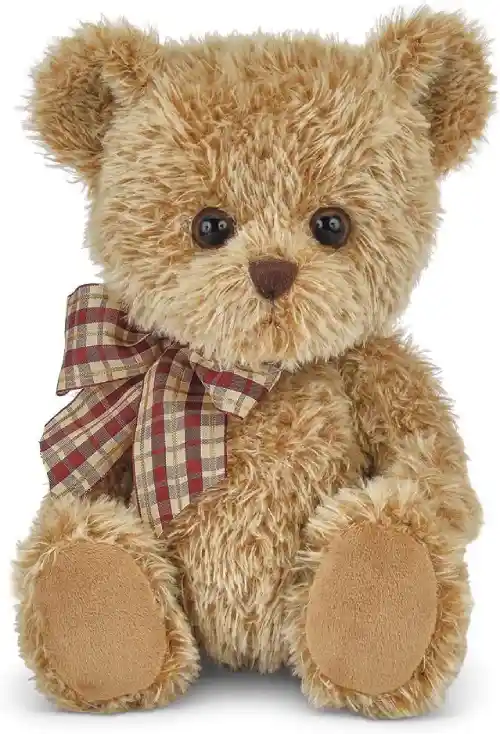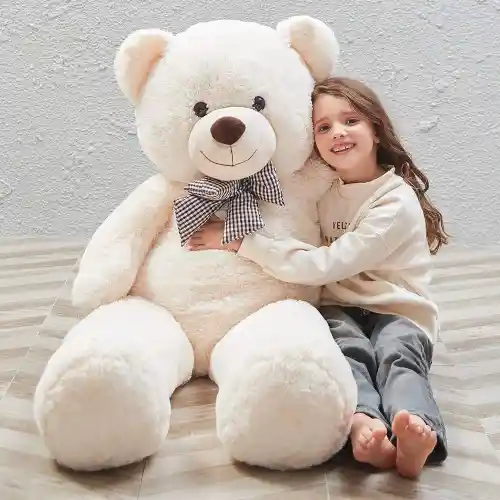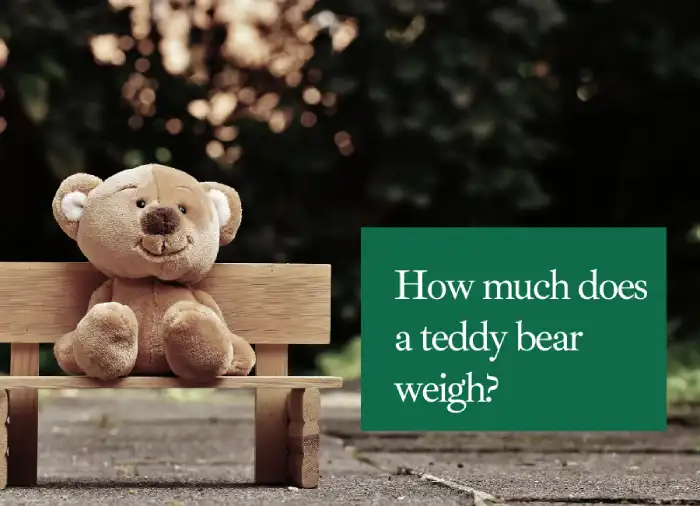Do you want to give your child a cute teddy but have no idea how it weighs? What size will suit them.
Or,
Love bears, but hate the hassle of having to pack them along when you go on vacation?
Well, fret no more!
On this blog, you will learn about the average weight of a teddy bear, as well as variations in teddy bear weights. Additionally, you will learn about the material from which teddy bears are made, as well as their size and quality.
You will find out whether or not adults sleep with teddy bears, and which color teddy is best.
We’ll also provide some tips on packing a teddy bear that will make it last longer.
What is a Stuffed Teddy Bear?
A teddy bear is a soft, cuddly toy that typically costs around $10-$20. Here you can check the cost of it in various types.
They come in many different shapes and sizes, but the small size of them actually starts from 6 ounces (170 gram approximate), and the big size of them is 60 ounces ( 1.5 kg).
An example of small teddy

A small Stuff teddy bear (for three years old)
An example of Big teddy

A Big teddy Bear for gifting best friend and girlfriend.
Teddy bears are made from various materials, including plush fabric, plastic, and foam and cotton batting, and they can vary in size from around 11 inch ( which is very small), to 50 inch( which is very big).
How are Teddy Bears Made?
Teddy bears are made from a variety of materials, including plush fabric and stuffing (usually foam), plastic eyes and noses, and sometimes even metal parts (like claws or teeth).
Each material has its own advantages and disadvantages; for example, fabric is soft but may not be as durable as other materials.
The manufacturing process also plays a role in Teddy Bear weight; some components (like metal) are heavier than others.
Ultimately, it’s important to choose a teddy bear weight that suits your specific needs—if you’re looking for a heavy gift, try choosing something with metal parts instead of plush fabric.
How to Pack a Teddy Bear Without Making a Mess?
If you’re planning to take your teddy bear on a trip, there are a few things you’ll need to know.
First of all, make sure you have the right size Teddy Bear – they come in different sizes and weights.
Secondly, be prepared for the weight difference – a small teddy bear may weigh less than a large one.
And finally, pack it properly – making sure it’s wrapped securely in newspaper or packing material and avoiding making any messes along the way. Thanks for reading!
Factors That Affect Teddy Bear Weight
There are a number of factors that can affect the weight of a teddy bear, including the material it is made from, the size and shape of the bear, as well as its quality. While all bears will vary in weight somewhat, on average, a typical teddy bear weighs about 2 pounds. There can be significant variation in weights, however – for example, one large plush toy might weigh more than 5 pounds.
While Teddy Bears may be most famous for being loved by children, adults also enjoy them – some even sleep with them! As such, it’s important to choose one that’s right for your intended recipient. Some factors to consider when selecting a teddy bear include:
Is the recipient young or old? Young children tend to love softer toys while older children may prefer heavier ones.
Do they have an affinity for specific characters or brands? A particular character or brand might be more appealing to one person than another.
Are they active or passive? Active people might want a bouncy toy while passive people might prefer something stationary.
Will they be using it regularly or just occasionally? If someone plans on keeping the toy around mostly unused then they may want something lighter in weight.
Conversely if someone plans on using their teddy frequently then something heavier would probably be better suited.
Material – size – Quality
Material
It’s important to consider the material it’s made from. Different materials are better suited for different purposes, and this will determine its weight and cost. Teddy bears made from soft materials like plush or cotton are light and affordable, but they may not be durable enough for children who are rough with toys.
Teddy bears made from more robust materials like hard plastic or metal are heavier and more expensive, but they’re also likely to last longer.
If you have a specific need for a heavy teddy bear that can withstand lots of wear and tear, these types of toys might be the right choice for you.
Size
Clothing, sizing can be very confusing. Not only do different brands use different sizes, but even within the same brand, sizes may vary greatly from item to item. This is why it’s so important to know your size before shopping for clothes.
Here are a few tips on how to determine your size:
- Measure yourself around the bust, waist, and hips. Use this information to find your measurements in inches and convert them into UK or US sizes.
- Compare the measurements you took above with the size chart provided by the brand you plan on buying clothing from. If there’s a discrepancy between your measurements and the size chart, go with the chart.
- If none of these solutions work for you or if you still don’t understand what size you are, contact customer service for help.
Quality
Make sure all of the materials used in your product are of high quality. This includes the fabric, thread, and other components.
Be sure to inspect each stage of production carefully to ensure that everything is done correctly and without defects.
Use quality testing procedures to confirm that your products meet your standards before releasing them into the market.
Advice on Choosing the Right Teddy Bear Weight
Choosing the right teddy bear weight can be tricky, but with a little bit of research you’ll be able to find the perfect fit for your loved ones. Here are some tips to help you choose the right bear:
- First and foremost, make sure to consider your family’s size and weight range. Not all bears are created equal, so it’s important that everyone in your household can enjoy them.
- Secondly, think about what type of bear you want. There are soft teddies, cuddly bears, and even fitness bears – so there’s something for everyone!
- And finally, take into account how often you plan on using your teddy bear. If you’re just going to keep him around the house or give him as a gift once in a while, then a smaller option may work better. But if you’re going to use him more regularly (like at bedtime), go for something bigger and heavier.
The Benefits of Having a Teddy Bear Collection
There are a lot of reasons to have a teddy bear collection, and we’re here to tell you about some of the benefits. Having a Teddy Bear Collection can bring many joys into your life, including:
1. A sense of nostalgia: When you look at your old teddies and remember all the memories they’ve shared with you, it will definitely bring back some good times. Plus, who doesn’t love feeling sentimental?
2. Comfort: When you curl up with your teddies every night before bed, they will help to make you feel safe and secure. Who wouldn’t want that? A teddy bear can provide comfort during hard times. Many people find solace in their collection when they are feeling overwhelmed by a situation or life event
3. Fun: Teddy Bears are such fun creatures – there’s always something new happening when one is around! Whether it’s playing tag or pretending to eat each other for dinner, these bears are sure to keep things lively.
4. Expression Of Love: Collecting teddy bears can be a way to show love for someone in your life. Whether you give them as gifts or keep them for yourself, teddy bears can be a sweet way to express your feelings.
5. Inspiration: Collecting teddy bears can be a great source of inspiration. Many people find that looking at their collection can help them to come up with creative ideas and solutions.
6. Entertainment: Teddy bears can provide hours of entertainment. Whether you are playing make believe with them, or simply taking them out for a walk, teddy bears can help to make life more enjoyable.
7. Collectible Value: A teddy bear collection can be a great investment. Many teddy bears appreciate in value over time, making them a great way to make money. 8. Hobby: Collecting teddy bears is a great hobby for people of all ages. Not only is it fun, but it can also be quite rewarding.
9. Memories: Teddy bears can be a great way to remember a special person or event. Many people find comfort in looking at their collection and remembering a fond memory.
10. Decor: Teddy bears can be a great way to decorate a room. Whether you choose to display them on a shelf or in a glass cabinet, teddy bears can add a touch of charm to any space.
11. Stress Relief: Cuddling a teddy bear can be an effective way to reduce stress and improve mental health. Studies have shown that hugging a stuffed animal can increase oxytocin and reduce cortisol levels, which can help to reduce feelings of anxiety and depression.
12. Companionship: Having a teddy bear collection can provide companionship when there is no one else around. Having a stuffed animal to talk to and confide in can help to fill the void when people feel lonely.
How many pounds does a teddy bear weigh?
The weight of a teddy bear can vary significantly depending on its size. Generally, smaller teddy bears weigh between one and two pounds, while larger teddy bears can weigh up to five pounds or more.
As with any stuffed animal, the materials used for construction, such as stuffing and fabric, affect the weight of the teddy bear. Additionally, the size of the bear has a major effect on the overall weight.
The larger the teddy bear, the more stuffing and fabric it requires, which increases its weight. Ultimately, the weight of a teddy bear will depend on the size and materials used to create it.
What should I weigh stuffed animals with?
When considering what to weigh stuffed animals with, it is important to select a device that is both precise and accurate.
Digital scales with high precision and accuracy are best suited for the task, as they will ensure that you are getting an accurate measurement of the weight of the stuffed animals.
You should look for a device that is easy to use and has the capacity to measure weights in a variety of different units.
This is important for allowing you to weigh stuffed animals with ease, as well as for enabling you to accurately compare the weights of different objects.
Digital scales can also be calibrated to ensure that the readings are as accurate as possible.
How much does a 7 ft teddy bear weigh?
A 7 ft stuffed teddy bear will weigh approximately 20 lbs. This weight is based on the size and type of plush material used for the bear.
The bear will likely be filled with stuffing and other materials, such as small beads or pellets, to give it a more realistic look and feel.
Due to the size of the bear, it is important to be aware of the weight and make sure that the floor or shelf it is placed on can support the bear.
If you are looking to purchase a 7 ft stuffed teddy bear, it is always best to consider the bear’s weight before deciding to buy.
How many ounces does a teddy bear weigh?
The average stuffed teddy bear weighs between 8-12 ounces, though this may vary depending on the size of the bear. Smaller bears may weigh as little as just a few ounces, while larger bears can weigh up to 50 ounces.
The material used for the bear also affects its weight, with bears made from heavier fabrics being heavier than those made from lighter materials.
The stuffing of the bear also plays a role, as bears with a greater amount of stuffing tend to weigh more. It is important to note that the weight of the bear may vary from retailer to retailer, so it is best to check with the store for exact weight information.
Conclusion
Knowing the weight of a teddy bear is important for many reasons. Being able to identify the exact weight of a teddy bear can help you determine if it’s safe for a child to use, as well as its overall size and sturdiness.
It’s also helpful when looking to buy or sell a teddy bear, as collectors may be more interested in certain weights that are harder to come by.
In general, heavier teddy bears are seen as higher quality because they typically contain better materials and have been put together with greater care.
However, it’s important to keep in mind that a heavier teddy bear does not necessarily indicate superior craftsmanship or design – it simply means that there is more material used in making them.


